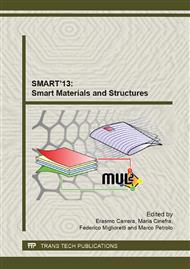[1]
W. J. Jung, N. Mangiavacchi, and R. Akhavan. Suppression of turbulence in wall-bounded flows by high-frequency spanwise oscillations. Phys. Fluids A, 4(8):1605--1607, 1992.
DOI: 10.1063/1.858381
Google Scholar
[2]
C. Viotti, M. Quadrio, and P. Luchini. Streamwise oscillation of spanwise velocity at the wall of a channel for turbulent drag reduction. Phys. Fluids, 21(115109), 2009.
DOI: 10.1063/1.3266945
Google Scholar
[3]
K-S. Choi and B. R. Clayton. The mechanism of turbulent drag reduction with wall oscillation. Int. J. Heat Fluid Flow, 22:1--9, 2001.[4] P. Ricco, C. Ottonelli, Y. Hasegawa, and M. Quadrio. Changes in turbulent dissipation in a channel flow with oscillating walls. J. Fluid Mech., 700:77--104, 2012.
DOI: 10.1017/jfm.2012.97
Google Scholar
[5]
L. Keefe. A normal vorticity actuator for near-wall modification of turbulent shear flows. AIAA Paper, 97-0547, 1997.
DOI: 10.2514/6.1997-547
Google Scholar
[6]
L. Keefe. Method and apparatus for reducing the drag of flows over surfaces. United States Patent, 5,803,409, 1998.
Google Scholar
[7]
P. Ricco and S. Hahn. Turbulent drag reduction through rotating discs. J. Fluid Mech., 722: 267--290, 2013.
DOI: 10.1017/jfm.2013.92
Google Scholar
[8]
J. F. Gibson. Channelflow: a spectral Navier-Stokes simulator in C++. "http://www.channelflow.org/'', 2006.
Google Scholar
[9]
L. Kleiser and U. Schumann. Treatment of incompressibility and boundary conditions in 3-D numerical spectral simulations of plane channel flows. In E. Hirschel, editor, Proc. 3rd GAMM Conf. Numerical Methods in Fluid Mechanics, pages 165--173. GAMM, Vieweg, 1980.
DOI: 10.1007/978-3-322-86146-7_17
Google Scholar
[10]
U.M. Ascher, S.J. Ruuth, and B.T.R. Wetton. Implicit-explicit methods for time-dependent partial differential equations. SIAM J. Numer. Anal., 32:797--823, 1995.
DOI: 10.1137/0732037
Google Scholar
[11]
J. O. Hinze. Turbulence. McGraw Hill, Inc. -- Second Edition, 1975.
Google Scholar
[12]
K-S. Choi, J. R. DeBisschop, and B. R. Clayton. Turbulent boundary-layer control by means of spanwise-wall oscillation. AIAA J., 36(7):1157--1162, 1998.
DOI: 10.2514/3.13948
Google Scholar
[13]
K. Fukagata, K. Iwamoto, and N. Kasagi. Contribution of Reynolds stress distribution to the skin friction in wall-bounded flows. Phys. Fluids, 14(11):73--76, 2002.
DOI: 10.1063/1.1516779
Google Scholar
[14]
S. B. Pope. Turbulent Flows. Cambridge University Press, 2000.
Google Scholar
[15]
D. Kuang-Chen Liu, J. Friend, and L. Yeo. A brief review of actuation at the micro-scale using electrostatics, electromagnetics and piezoelectric ultrasonics. Acoust. Sci. & Tech., 31:115 -- 123, 2010.
DOI: 10.1250/ast.31.115
Google Scholar
[16]
L.G. Frechette, S.A. Jacobson, K.S. Breuer, F.F. Ehrich, R. Ghodssi, R. Khanna, C.W. Wong, X. Zhang, M.A. Schmidt, and A.H. Epstein. High-speed microfabricated silicon turbomachinery and fluid film bearings. J. Microel. Sys., 14(1):141--152, 2005.
DOI: 10.1109/jmems.2004.839008
Google Scholar
[17]
A.P. Willis, Y. Hwang, and C. Cossu. Optimally amplified large-scale streaks and drag reduction in turbulent pipe flow. Phys. Rev. E, 82(036321), 2010.
DOI: 10.1103/physreve.82.036321
Google Scholar
[18]
A.S. Sharma, J.F. Morrison, B.J. McKeon, D.J.N. Limebeer, W.H. Koberg, and S.J. Sherwin. Relaminarisation of Re=100 channel flow with globally stabilising linear feedback control. Phys. Fluids, 23(125105):1--7, 2011.
DOI: 10.1063/1.3662449
Google Scholar
[19]
M. Gad-el Hak. Compliant coatings for drag reduction. Progr. Aerosp. Sc., 38:77--99, 2002.
DOI: 10.1016/s0376-0421(01)00020-3
Google Scholar
[20]
P.R. Viswanath. Aircraft viscous drag reduction using riblets. Progr. Aero. Sc., 38:571--600, 2002.
DOI: 10.1016/s0376-0421(02)00048-9
Google Scholar


